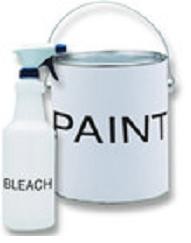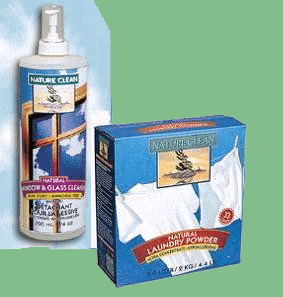Home & Yard

Landscaping, whether it’s mowing the grass, weed trimming or planting a flower garden, is an enjoyable activity that provides a certain aesthetic quality to our waterfront property. Choose projects that help make your shoreline healthier, help to protect your property from erosion, and improve the ability of your buffer to protect water quality. If you have an undisturbed natural shoreline, the best thing you can do is leave as much of it alone as you can.
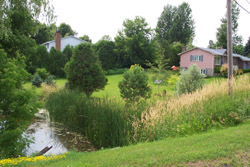
Clean and tidy lawns make dirty lakes and streams. They can speed up runoff, contribute to soil erosion and add chemicals from the fertilizers and pesticides used on them. Detergents and cleaners from your home as well as waste from septic systems also pose a threat to our waterways. Reduce the risk of contamination by maintaining septic systems, conserving water and reducing the use of toxic chemicals in and around your home.
FAQs
- What are some ways I can conserve water?
- I have a dead tree on my shoreline that I would like to cut down, but I’ve been told it is better to leave it alone. Is this true?
- I have a grassy lawn to the water’s edge. How do I start a buffer strip?
- What tips do you have for my lawn?
1. Conserving water doesn’t mean doing without; it’s about reducing what we waste. Through REDUCING, REPAIRING, and RETROFITTING, you can reduce the water you waste, save yourself money, and protect investments like septic systems.
Here are a few suggestions:
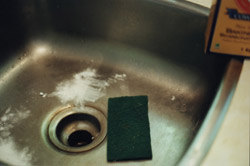
* Install a low-flush toilet; this can reduce your water usage by 40 - 50%.
* Retrofitting your existing toilet with a water-saving device can reduce your water usage by up to 20% (45,000 litres a year for a family of four)!
* Do a simple dye test on your toilet to check that it is not running all the time; place a couple of drops of food coloring in the tank and monitor whether it seeps into the bowl. If it does, you will need to replace the tank flapper.
* If you have a septic system: stagger your washing over several days. This prevents overloading the system with large volumes of water at once.
2. A shoreline with plants of various ages is a healthy shoreline. Trees and shrubs ranging in age and types help provide the necessary layers for wildlife habitat and indicate that a shoreline is renewing itself. Having a few dead trees is normal and healthy. Dead trees provide habitat for many kinds of wildlife, and as they decay, gradually return nutrients to the soil. Leave dead trees alone on your shoreline, even in urban areas. When trees fall, they help protect shorelines and streambanks from erosion, provide sources of food for fish and other wildlife, and create pools for fish.
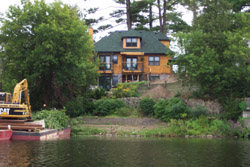
* Allow your standing dead trees to remain. They help anchor soil, and provide shade for new seedlings.
* If you are concerned about safety, rather than felling the tree, have it trimmed to a height of three to four metres, keeping some branches for perching.
* This job can be done by a tree pruning specialist.
* When trees fall into lakes or streams, let them be.
3. Starting a buffer strip can be easy – Mother Nature will do most of the work for you!
* Leave a few feet of lawn unmowed by the water’s edge.
* Mark off your buffer strip by tying string or ribbon to stakes to remind you not to mow. Keep the edge a little “ragged”
* wildlife and nature prefer flowing lines to straight.
* Refrain from pulling plants that show up in your buffer strip, unless you know for sure they are invasive ones!
* Watch as new plants appear over time. Sit back and enjoy your natural, low maintenance vegetation! In the first year, you’ll see wildflowers and your grass will get taller. Uncut grass grows longer roots, helping to hold your shoreline together. By about the third year, you’ll see shrubs starting to move in.
* Consider increasing your buffer’s width a little bit more each year. Ultimately, the wider the buffer the better.
If your shoreline area has been heavily cleared, you can help speed up the process of creating a buffer by planting some native shrubs or trees.
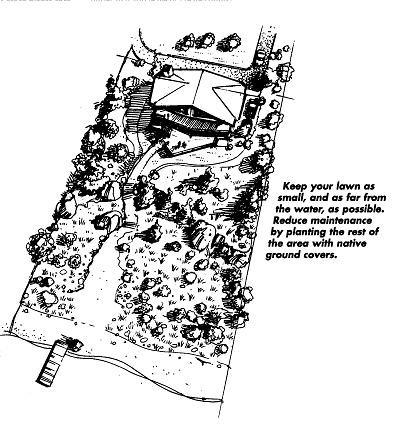
4. Plan for the smallest possible lawn, built on the opposite side of your home from the water. If you already have a property with a lawn to the water’s edge, read the tips on starting a buffer zone.
Consider replacing some of the grass in your lawn with clover or other groundcovers that don’t need watering. Good lawn maintenance practices will keep your grass healthier and reduce your need for fertilizers and pesticides.
* “Grasscycle”: Use a mulching mower and leave grass clippings on your lawn where possible. They can increase your soil’s fertility by up to 50 percent! The clippings will be gone in about two to three days as they turn into food for your turf’s roots.
* Keep clippings well back from water and drainage ditches. Never push them over the edge of a bank into a ravine, river or lake.
* Mow when the grass is dry to prevent clumping.
* Increase the mowing height of your lawn to approximately 8 cm (2.5 cm). Taller grass provides shade for better root growth, which helps with absorption.
* Keep lawn mower blades sharp so you don’t tear the grass; this can result in increased water loss and susceptibility to disease.
* Before you consider fertilizing your lawn, aerate it and see if that improves its health. If you still believe fertilizer is necessary, take a sample of your soil to a nursery or agricultural field office for testing.
* Choose a fertilizer high in Water Insoluble Nitrogen (WIN). WIN is released slowly and helps prevent “lawn bum” and groundwater contamination. WIN fertilizers cost more, but they’re worth it.
* Remove dandelions and other unwanted plants from your lawn using long-handled tools. Invest in a good quality weed remover; check with your local gardening centre. If you feel you must use a pesticide, do not apply it to the whole lawn. Instead, use an applicator which allows you to direct a small spray towards each unwanted plant. Avoid products like the fertilizer / herbicide mixes which provide blanket applications.
Watering tips for your lawn
* Don’t water at the first sign of spring. Holding water back at first will encourage root growth and make for sturdier, more drought tolerant plants.
* Encourage deep rooting by watering infrequently yet thoroughly. Soak grass with 2 to 3 cm of water, every 5 to 7 days (this will produce stronger, healthier grass). Water in the early morning, and don’t overwater. If you exceed the lawn’s capacity to absorb water, you’re wasting water and money and increasing the potential for shoreline damage from runoff and erosion.
* In hot dry weather, allow lawn grasses to go into a state of dormancy so that they require less water and nutrient intake for survival. Water ¼ to ½ inch (about 2/3 to 1 1/4 cm) every two or three weeks to keep crowns from dehydrating beyond the point of recovery.
* Use a water sprinkler that delivers large flat drops and has an adjustable range; this style reduces waste and unnecessary evaporation.
